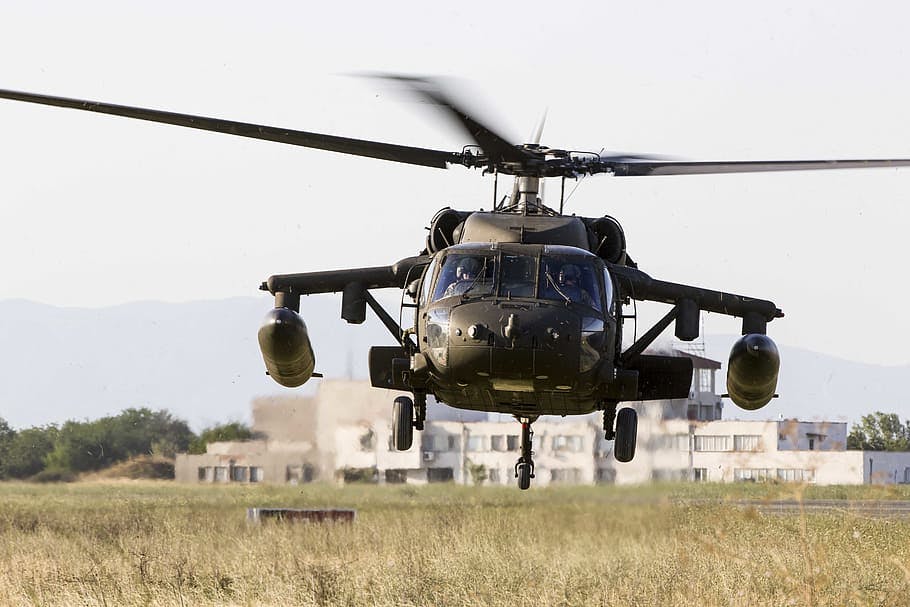Important Parts of the UH60 Blackhawk Helicopter and Their Roles in Helicopter Procedure

The UH-60 Blackhawk helicopter is a multifaceted aircraft, characterized by several crucial components that play important duties in its functional performance. From its advanced rotor system that optimizes aerodynamics to the reputable T700-GE-701C engines making certain peak performance, each part is elaborately made to satisfy specific features. Moreover, the innovative avionics suite enhances navigation and interaction, while the durable airframe and tri-cycle touchdown gear add to its flexibility throughout numerous missions. Comprehending these parts is important, as they collectively shape the helicopter's capacities in varied settings and situations. What implications do these functions hold for objective success?
Rotor System

The rotor blades are created from innovative composite materials, permitting for lowered weight and enhanced durability - UH60 Blackhawk Helicopter. The cutting-edge style includes a fully articulated rotor head, which facilitates smooth and responsive handling by allowing blade flapping and feathering. This flexibility is vital for steering in different functional atmospheres, including mountainous and metropolitan terrains
The rotor system's efficiency and dependability contribute substantially to the Blackhawk's overall efficiency, making it a necessary possession for different military and civilian goals. The integration of innovative modern technology in the rotor system emphasizes the Blackhawk's status as a versatile and powerful helicopter in modern-day air travel.
Engine Elements
Reliable and powerful engine parts are essential to the efficiency of the UH60 Blackhawk helicopter. At the core of its procedure are the T700-GE-701C turboshaft engines, which supply the necessary thrust and integrity for different goals. Each engine produces around 1,800 shaft horse power, allowing the helicopter to perform in varied settings and conditions.
The engine's layout incorporates a multi-stage axial and centrifugal compressor, which optimizes air flow and boosts total effectiveness. This is complemented by the use innovative materials and cooling down technologies, making sure that the engine runs properly also under high-stress situations. The dual-engine setup offers redundancy, boosting security and operational capacity in the event of an engine failure.
In addition, the engine control system plays a vital duty in managing engine performance, readjusting gas flow and various other specifications to maintain optimal procedure. Integrated health and wellness surveillance systems continually analyze engine standing, supplying real-time information that help in upkeep and functional decision-making.
Avionics Collection
Central to the operational abilities of the UH60 Blackhawk helicopter is its advanced avionics suite, which incorporates innovative navigation, communication, and flight control systems. This suite boosts situational recognition and functional effectiveness, permitting pilots to perform complicated goals in varied atmospheres.
The Blackhawk's avionics collection features a digital trip control system that automates various trip jobs, lowering pilot work and increasing safety throughout important operations. The system consists of a multi-function display screen that gives real-time information on aircraft objective, navigation, and performance parameters, allowing informed decision-making.

Moreover, the suite is geared up with advanced weather condition radar and surface recognition systems, improving functional abilities in unfavorable weather. The mix of these technologies makes sure that the UH60 Blackhawk can effectively perform a variety of goals, from troop transportation to clinical emptying, while preserving a high level of safety and dependability.
Airframe Framework
A robust airframe structure is necessary for the UH60 Blackhawk helicopter, making sure durability and efficiency sought after operational settings. The airframe is constructed from sophisticated composite products and aluminum alloys, which supply a favorable strength-to-weight proportion. This design reduces total weight while optimizing architectural honesty, essential for the helicopter's dexterity and fuel efficiency.
The airframe's style additionally integrates features that enhance survivability and minimize maintenance requirements. The use of safety layers and corrosion-resistant materials helps alleviate wear from ecological direct exposure. In addition, the airframe's modular style enables for less complicated repair services and upgrades, adding to the helicopter's longevity and operational readiness.
Aerodynamically, the airframe is streamlined to reduce drag, making it possible for the get redirected here Blackhawk to accomplish outstanding speed and maneuverability - UH60 Blackhawk Helicopter. The fuselage's configuration sustains various goal accounts, from troop transportation to clinical emptying, by supplying sufficient area for workers and equipment while preserving security during trip
Touchdown Equipment
While the airframe of the UH60 Blackhawk offers essential architectural support, the landing equipment plays a critical role in making sure risk-free operations throughout ground, landing, and takeoff maneuvers. The UH60 is outfitted with a tri-cycle landing equipment system, making up 2 primary wheels and a tail wheel, which supplies security and equilibrium when the helicopter gets on the ground.
The primary wheels are designed to take in shock throughout touchdown and help with smooth taxiing cab on various surfaces. The gear's durable design enables the helicopter to endure significant forces experienced throughout harsh landings or ground operations. In addition, the wheels are fitted with tires that offer superb grip, making certain trustworthy performance in diverse settings, consisting of soft or irregular surface.

Conclusion
In summary, the UH-60 Blackhawk helicopter's functional performance is attributable to its Bonuses integral elements. Collectively, these components add to the helicopter's capability to do a wide array of missions efficiently.
The rotor system of the UH60 Blackhawk helicopter is an important component that operates with amazing effectiveness. The assimilation of sophisticated modern technology in the blades system underscores the Blackhawk's status as a formidable and flexible helicopter in contemporary air travel.
Reliable and effective engine parts are basic to the performance of the UH60 Blackhawk helicopter.A durable airframe structure is crucial for the UH60 Blackhawk helicopter, making certain resilience and performance in demanding functional environments. UH60 Blackhawk Helicopter. Overall, the landing equipment of the UH60 Blackhawk is a crucial element that boosts functional security and effectiveness, sustaining the helicopter's versatility in various objective profiles